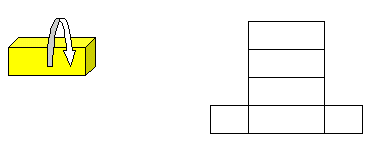In this activity students will try to identify 3D solid shapes from drawings of the faces of these solids. This involves pairs of students playing a game. Students will work in pairs to draw the faces of 3D solid shapes. They will then try to identify the solid shapes by matching the drawn faces to the solids.
Hand out a collection of solid shapes to each pair, for example, a cube, a rectangular prism, a cylinder.
Adaptation for ESOL students: Take this chance to recycle the names of the shapes.
Adaptation for ESOL students: Model tracing. Have group of students watch while one or two students trace the faces of a shape while you model the language. Remember to use the words 'along' for sides and 'around' for corners (as taught in Level 1). In pairs, students are to trace all of the faces of 1 solid shape onto a single sheet of paper. Partners swap sheets with another pair. The other pair has to match the solids with the drawings of the faces. Pairs then check guesses.
Adaptation for ESOL students: Check for accurate use of the language. Spend more time on this if necessary to give children confidence with the language.
In this activity the students will be exploring making a net from solid shapes by drawing round 3D solid shapes as they roll a shape along a piece of paper.

Adaptation for ESOL students: Introduce the word 'net'. Talk about its other uses, some may be known, and explain this mathematical use. Demonstrate. Add the word to the vocabulary chart. Recycle this word as often as possible in the discussions that follow.
Working in pairs students select a solid shape to 'unwrap'.
Adaptation for ESOL students: Model the next procedure and talk about it as you do it. Students are to unwrap the solid by rolling the shape and tracing the faces as they roll. Remember to roll the shapes sideways as well. Students can then investigate how many different nets they can make with their shape by rolling the shape in different ways. The result should resemble a net for the shape. Students cut out the nets for the shape and fold them together to establish which design makes their solid shape. They may need support to fold the lines that they have made. Conclude the session by giving the students a package from Session 1 to carefully unpack to form a net. Look at the similarities and differences between the packages and the drawn nets.
Adaptation for ESOL students: Encourage use of mathematical language. Display the packages that have been unpacked as nets.
Adaptation for ESOL students: Talk about the 'solids' and the 'nets', recycling the new vocabulary.
Published on: 09 Jan 2018
